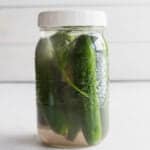Homemade Fermented Pickles
Homemade fermented pickles couldn’t be easier or more delicious. This is seriously the simplest recipe ever and makes the best tasting, probiotic, mildly sour pickles.
Servings: 4 servings
Equipment
- 1 32-ounce (1 quart) mason jar
- 1 Fermentation Weight (optional)
- 1 Fermentation Lid (optional)
Ingredients
- 7 mini cucumbers or 2 medium cucumbers, sliced
- 4 cups filtered water if using a scale, amount to be determined
- 2 tablespoons sea salt if using a scale, amount to be determined
- Dried bay leaves and fresh dill optional
Instructions
- Wash your cucumbers thoroughly, and clean your mason jar with hot, soapy water. Rinse well and set aside. Choose a mason jar that comfortably fits the cucumbers. A 32 oz (one-quart) wide-mouth mason jar works well. If using a kitchen scale, place the empty jar on the scale and press "tare" to zero out the weight.
- Pack the mini cucumbers into the jar, then pour in enough water to fully cover them. In a 32 oz (one-quart) jar, this would be approximately 4 cups of water. If using a kitchen scale, take note of the total weight in grams of both the cucumbers and water.
- If using volume measurements, add 2 tablespoons of salt to the jar. To determine the amount of salt needed, multiply that number by 0.035 to achieve a 3.5% brine. For example, if the combined weight is 860 grams, multiply 860 by 0.035 to get 30. You would add 30 grams of salt.
- Tare the scale again, then add the calculated amount of salt. Secure the lid and shake well to dissolve.
- If desired, add bay leaves and fresh dill for extra flavor.
- Ensure the cucumbers stay fully submerged. You can use fermentation weights, a small pinch bowl, or another small mason jar to hold them down before sealing the lid.
- Leave the jar at room temperature, away from direct sunlight, for about three to five days. Check daily to ensure the cucumbers remain submerged. Slightly open the lid each day to release built-up pressure, then close it again.
- Once the pickles reach your desired flavor, transfer the jar to the fridge to slow the fermentation process.
Video
Notes
- It is normal for the saltwater brine to get cloudy. This is a natural byproduct of vegetable fermentation, cloudy brine does not mean mold.
- Add in optional herbs such as fresh dill, garlic, parsley, or peppercorns. If you want to make dill pickles, add about one head of fresh dill per half quart.
- Take a pickle out and try it when you feel it has had enough fermentation time. If it is sour enough for you, put the lid on tightly, and throw the jar in the fridge. If you would like them to get a little more sour, leave them out at room temperature to ferment a little longer.
- After you make your first batch, you can use some of the brine to make your next batch of probiotic pickles. It already contains a plethora of good bacteria, so you’ll be giving your next batch a head start.
- You can easily double this recipe by using two quart jars or one half-gallon jar.
Nutrition
Serving: 1serving | Calories: 79kcal | Carbohydrates: 19g | Protein: 3g | Fat: 1g | Saturated Fat: 0.2g | Polyunsaturated Fat: 0.2g | Monounsaturated Fat: 0.03g | Sodium: 3511mg | Potassium: 772mg | Fiber: 3g | Sugar: 9g | Vitamin A: 551IU | Vitamin C: 15mg | Calcium: 93mg | Iron: 2mg
